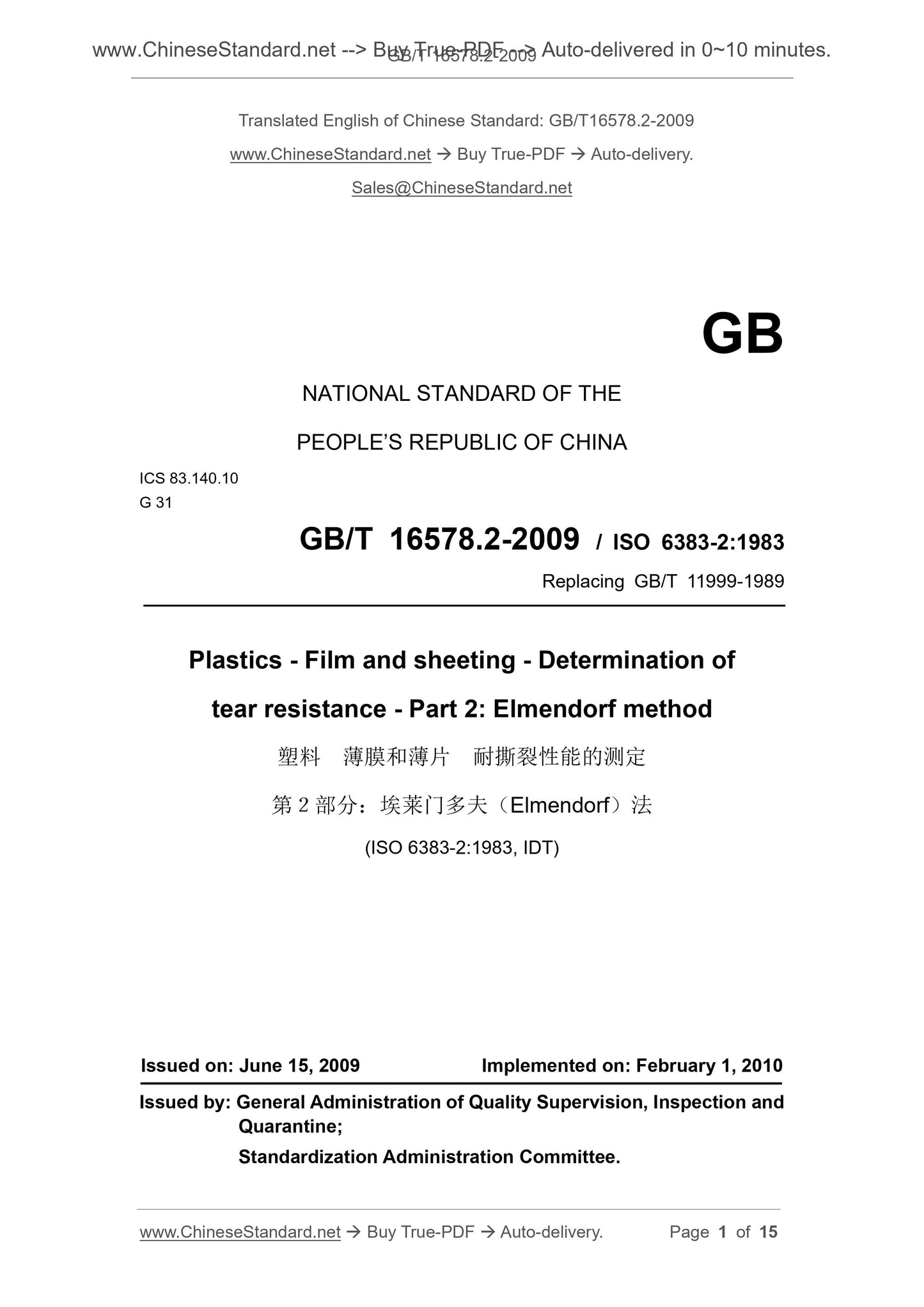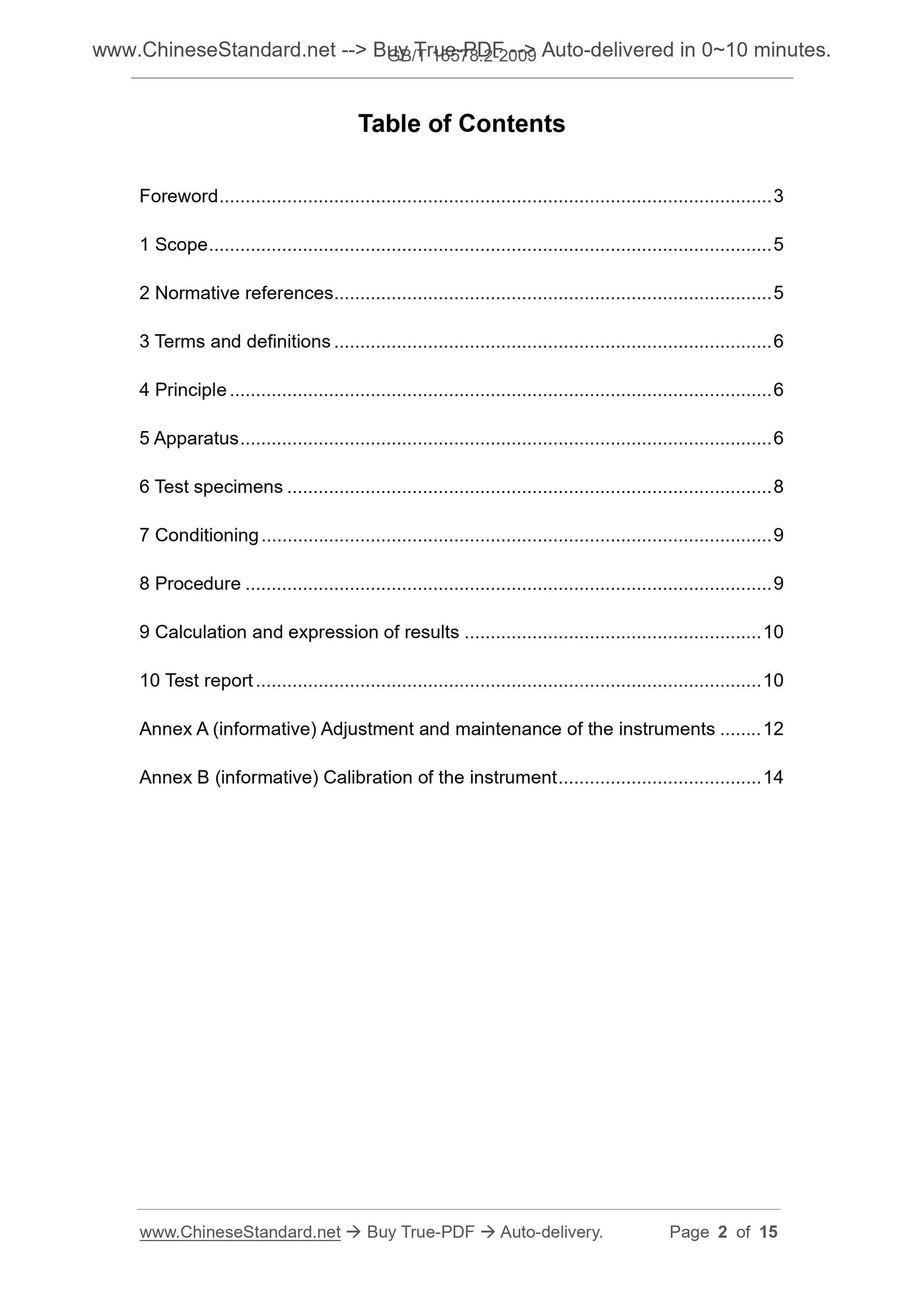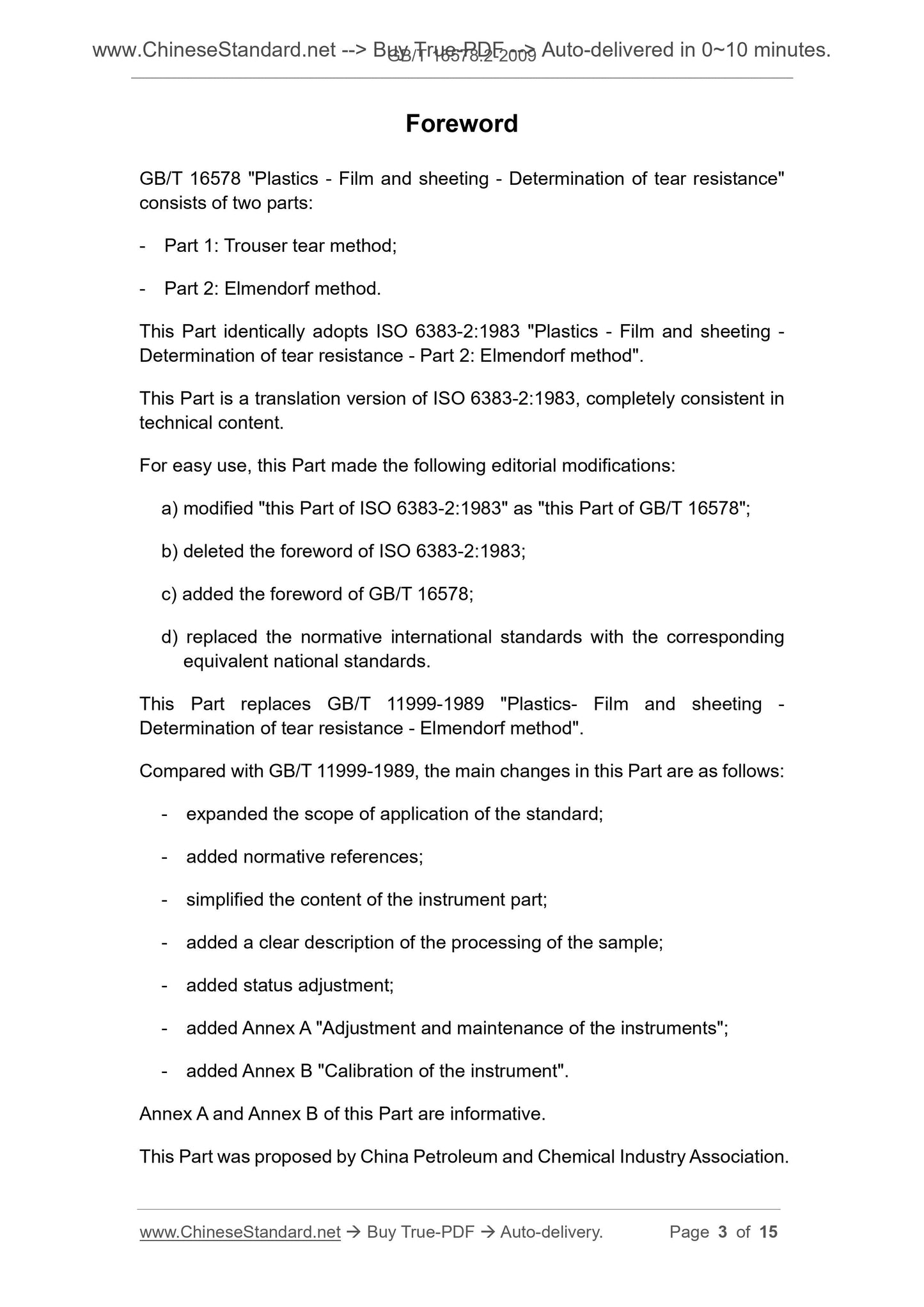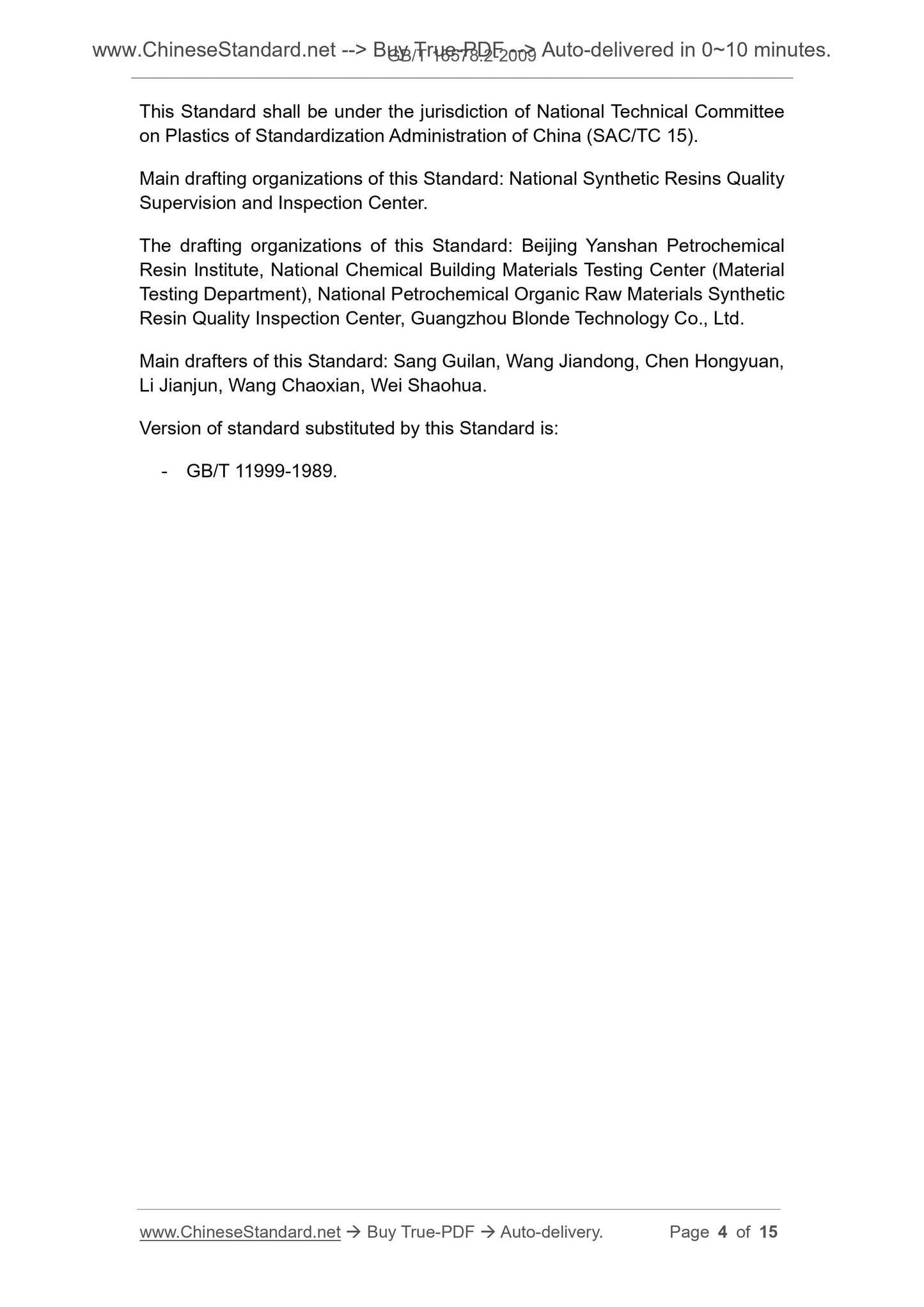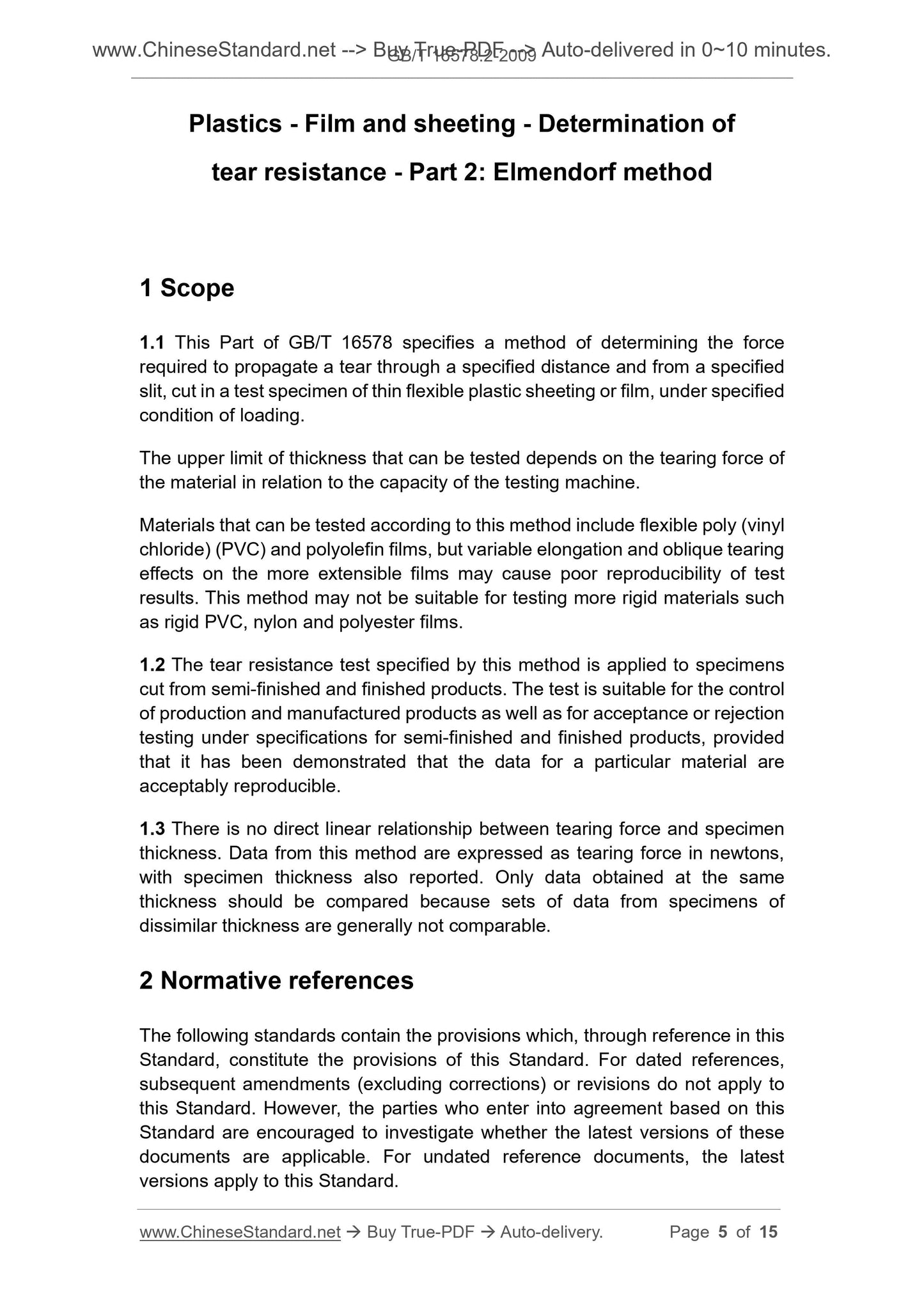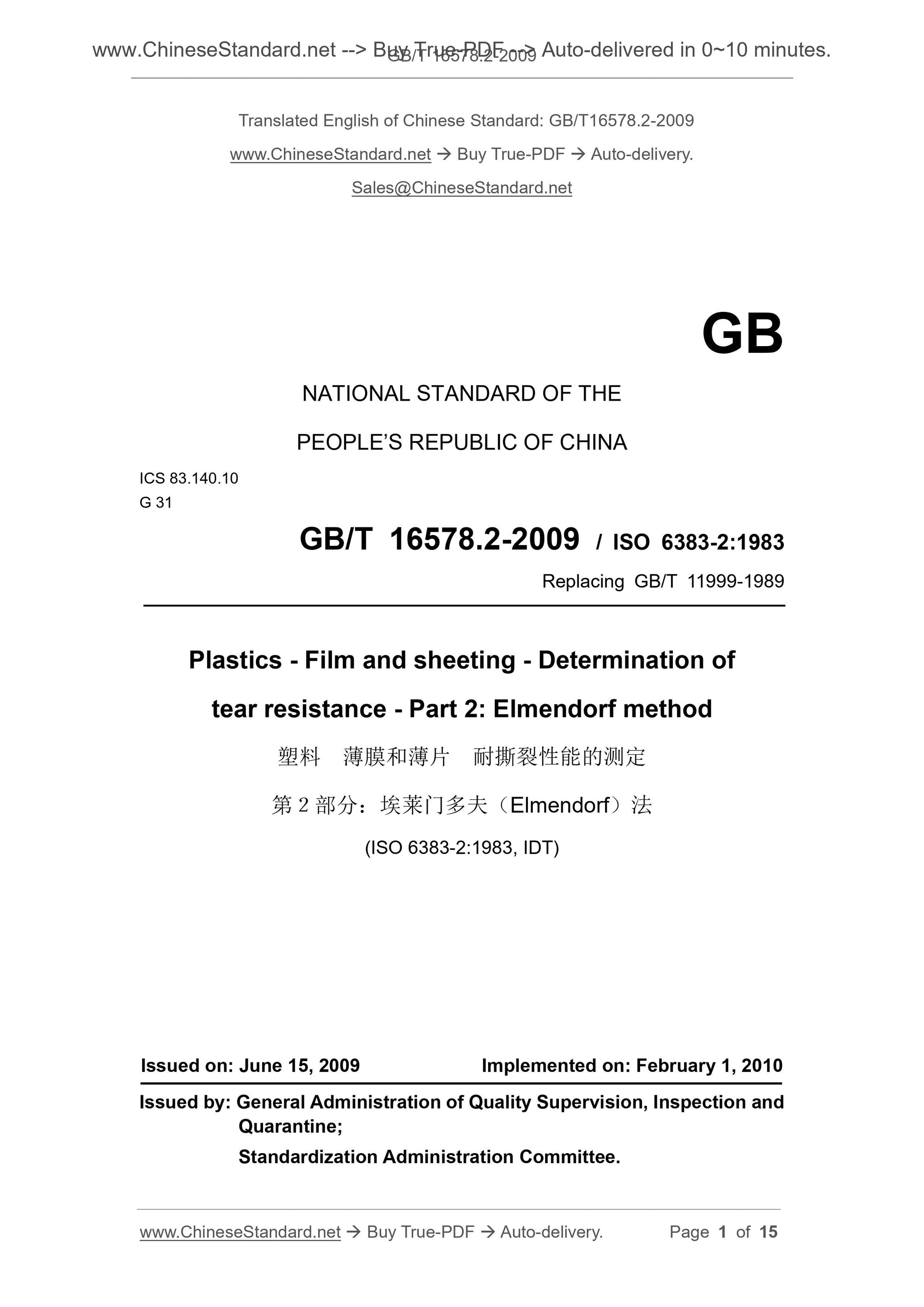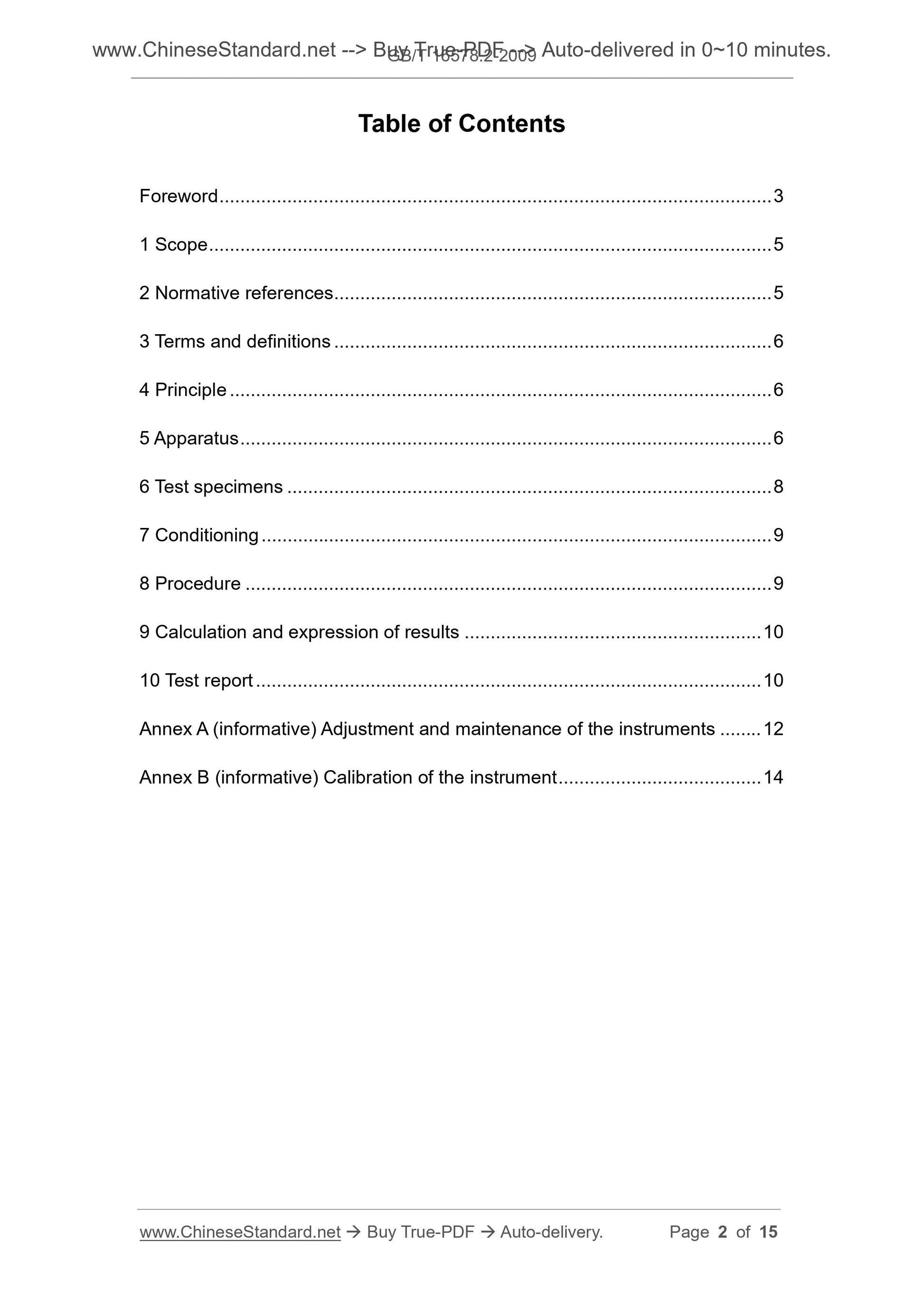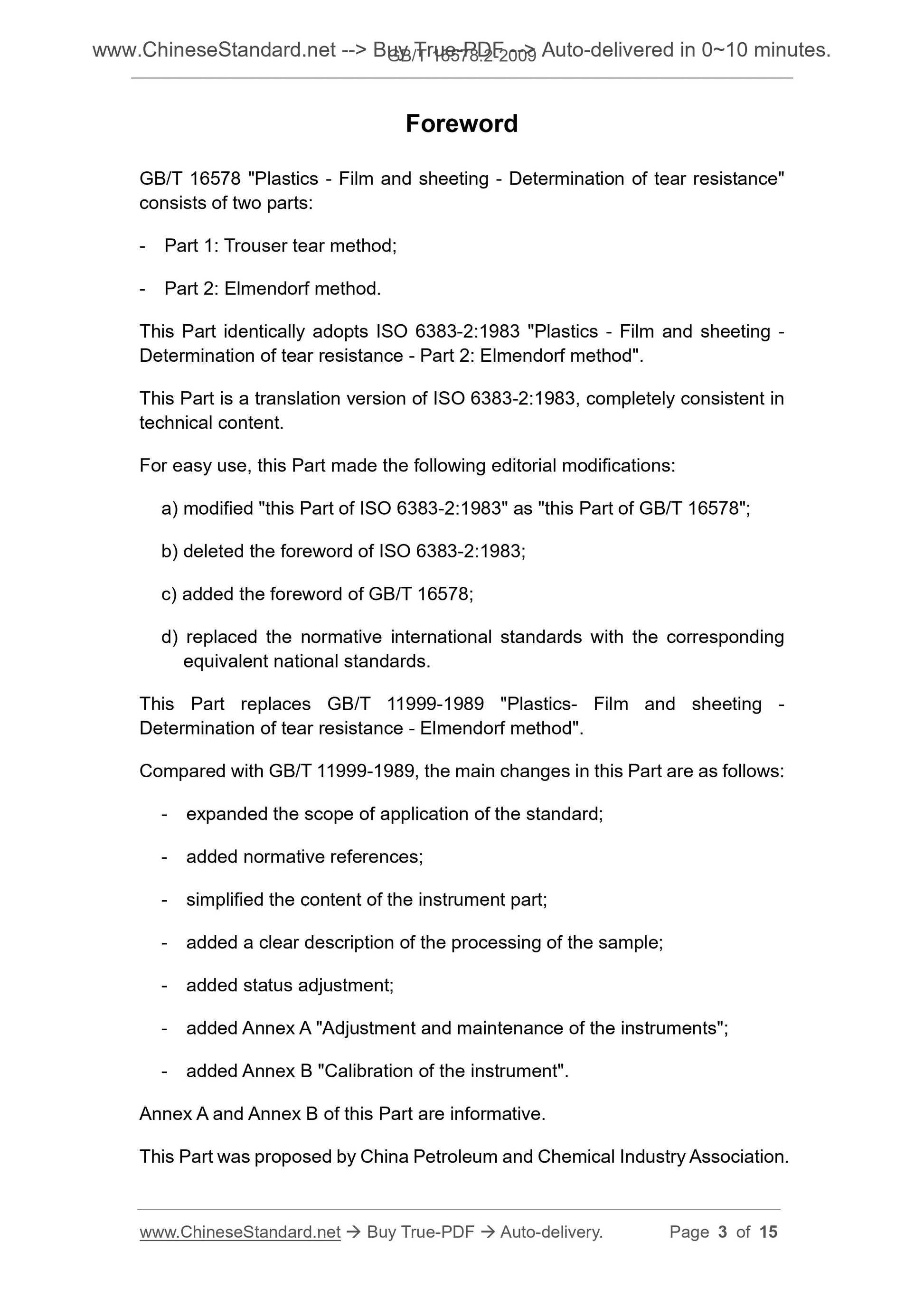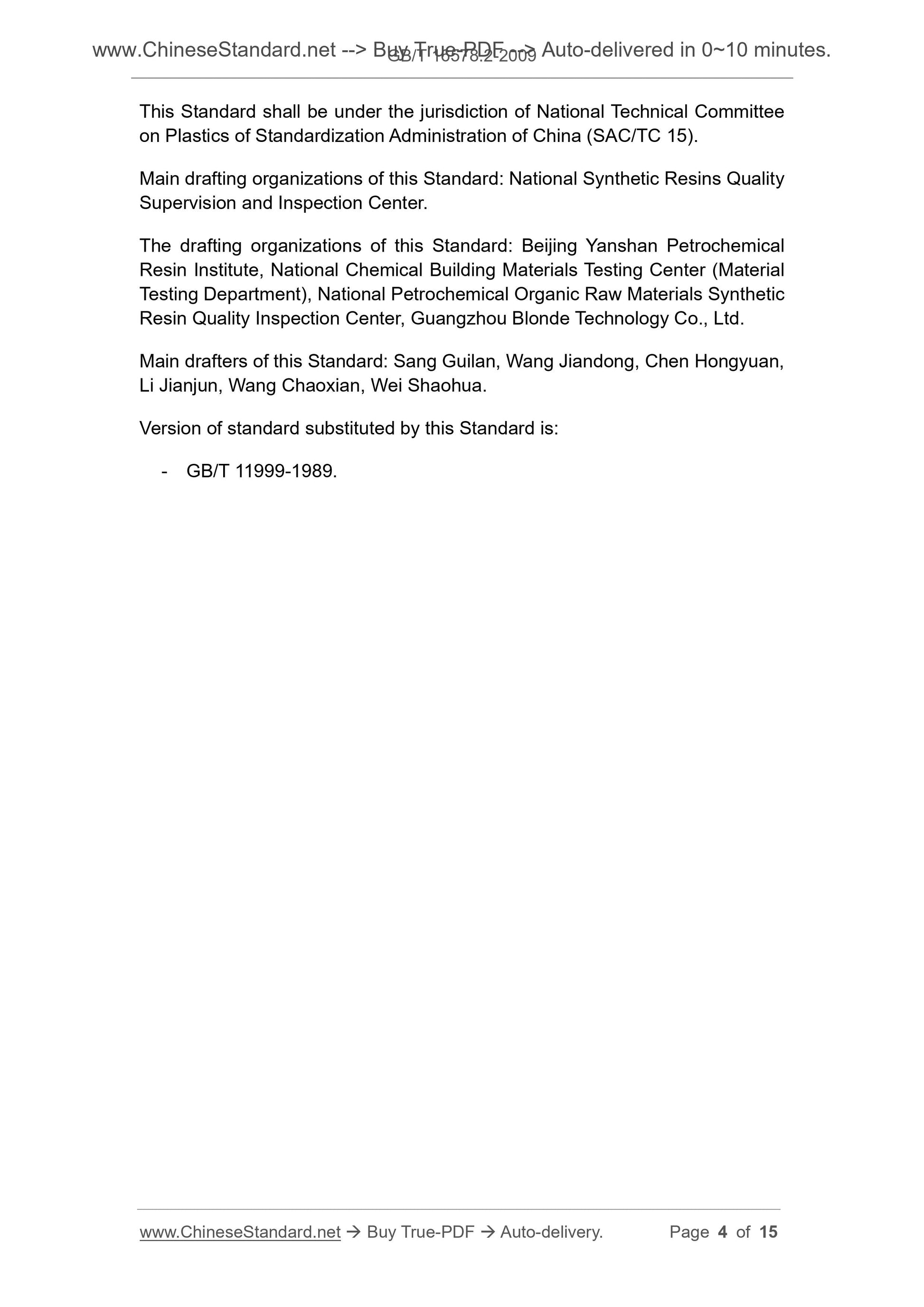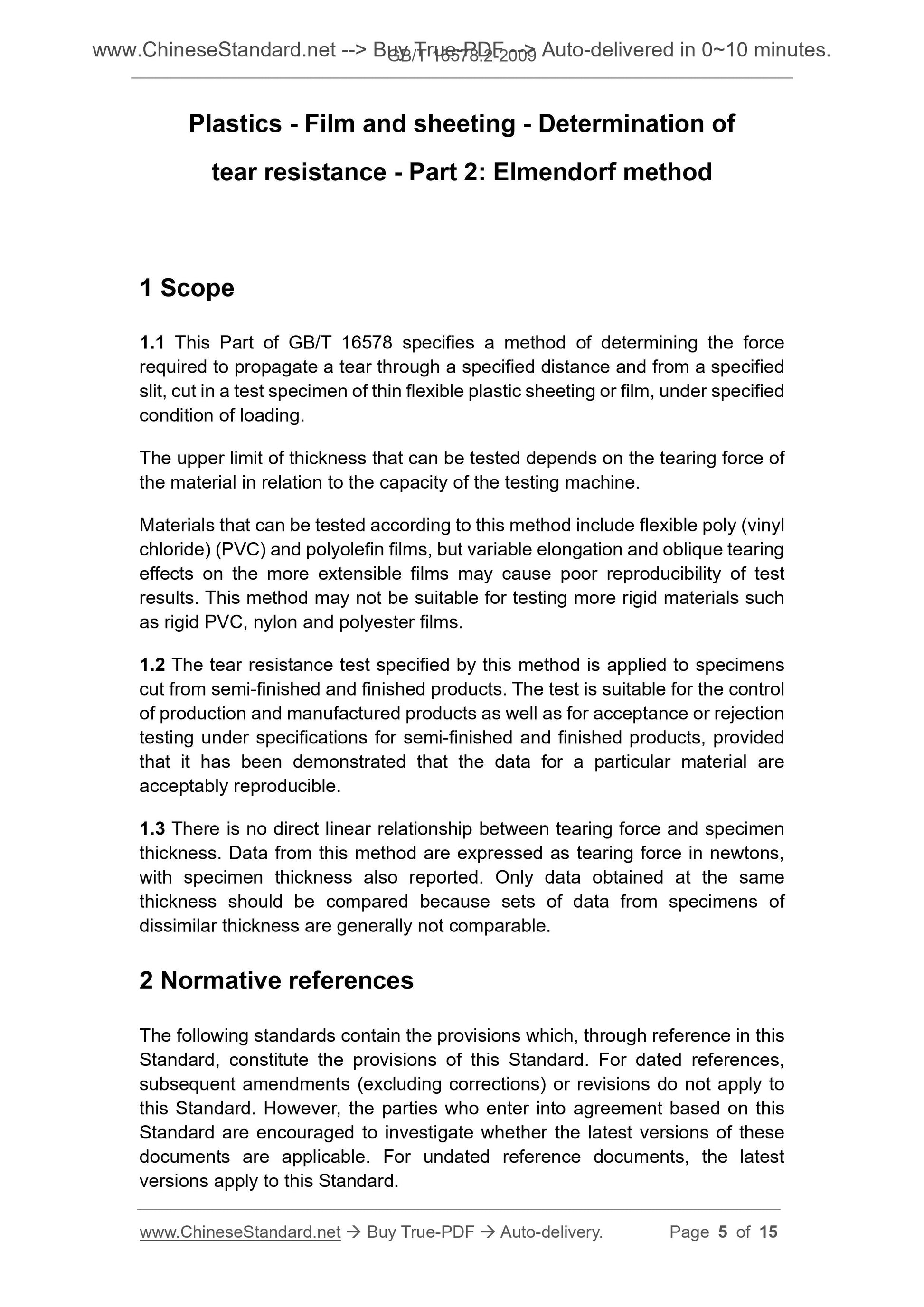1
/
of
5
PayPal, credit cards. Download editable-PDF and invoice in 1 second!
GB/T 16578.2-2009 English PDF (GBT16578.2-2009)
GB/T 16578.2-2009 English PDF (GBT16578.2-2009)
Regular price
$140.00 USD
Regular price
Sale price
$140.00 USD
Unit price
/
per
Shipping calculated at checkout.
Couldn't load pickup availability
Delivery: 3 seconds. Download true-PDF + Invoice.
Get QUOTATION in 1-minute: Click GB/T 16578.2-2009
Historical versions: GB/T 16578.2-2009
Preview True-PDF (Reload/Scroll if blank)
GB/T 16578.2-2009: Plastics -- Film and sheeting -- Determination of tear resistance -- Part 2: Elmendorf method
GB/T 16578.2-2009
Plastics.Film and sheeting.Determination of tear resistance.Part 2. Elmendorf method
ICS 83.140.10
G31
National Standards of People's Republic of China
GB/T 16578.2-2009/ISO 6383-2. 1983
Replace GB/T 11999-1989
Determination of tear resistance of plastic films and sheets
(ISO 6383-2.1983, IDT)
Released on.2009-06-15
2010-02-01 implementation
General Administration of Quality Supervision, Inspection and Quarantine of the People's Republic of China
China National Standardization Administration issued
Foreword
GB/T 16578 "Determination of tear resistance of plastic film and sheet" is divided into two parts.
--- Part 1. Pant tear method;
--- Part 2. Elmendor law.
This part is equivalent to ISO 6383-2.1983 "Determination of tear resistance of plastic films and sheets - Part 2. Elmendo
Elmendor Act.
This part is equivalent to translation ISO 6383-2.1983, which is completely consistent in technical content.
For ease of use, this section has made the following editorial changes.
a) Replace “ISO 6383-2.1983 of this part of ISO 6383” with “this part of GB/T 16578”;
b) removed the preface to ISO 6383-2.1983;
c) an introduction to the preamble of national standards;
d) Replace the normatively cited international standards with the corresponding national standards that are equivalent to the standard.
This part replaces GB/T 11999-1989 "Electronic film and sheet tear resistance test method Elemendorf method".
The main changes in this section compared with GB/T 11999-1989 are as follows.
--- Expanded the scope of application of the standard;
--- Added normative references;
--- Simplified the content of the instrument part;
--- Added a clear description of the processing of the sample;
--- Added status adjustment content;
--- Added Appendix A, "Adjustment and Maintenance of Instruments";
--- Added Appendix B, "Calibration of Instruments."
Appendix A and Appendix B of this part are informative annexes.
This section was proposed by the China Petroleum and Chemical Industry Association.
This part is under the jurisdiction of the National Plastics Standardization Technical Committee (SAC/TC15).
This standard is drafted by. National Synthetic Resin Quality Supervision and Inspection Center.
Participated in the drafting of this standard. Beijing Yanshan Petrochemical Resin Institute, National Chemical Building Materials Testing Center (Material Testing Department), National Petrochemical
Organic Raw Material Synthetic Resin Quality Inspection Center, Guangzhou Blonde Technology Co., Ltd.
The main drafters of this section. Sang Guilan, Wang Jiandong, Chen Hongyuan, Li Jianjun, Wang Chaoxian, Wei Shaohua.
The previous versions of the standards replaced by this section are.
---GB/T 11999-1989.
GB/T 16578.2-2009/ISO 6383-2. 1983
Determination of tear resistance of plastic films and sheets
1 range
1.1 This part of GB/T 16578 provides for the cutting of a gauge on a thin, soft plastic sheet or film under specified load conditions.
The fixed incision measures the force required to extend the tear of the incision to a prescribed distance.
The upper limit of the thickness of the specimen depends on the tearing force of the material associated with the range of the test machine.
This section applies to soft polyvinyl chloride (PVC) and polyolefin film materials, but varying elongation and oblique tearing will stretch
Longer films have poor test repeatability. This method is not suitable for hard materials such as rigid polyvinyl chloride, polyamide and polyester film.
1.2 This section also applies to specimens cut from finished and semi-finished products. When the test data has good repeatability, the method can be used as a quality
Specification for acceptance, acceptance, or rejection of quantity control, finished or semi-finished products.
1.3 There is no direct linear relationship between tear strength and sample thickness. The results obtained by this method are expressed by the tearing force (in Newtons).
The sample thickness should be reported. Only the data obtained at the same thickness can be compared because the data obtained from samples of different thicknesses
Often unmatched.
2 Normative references
The provisions in the following documents become the provisions of this part by reference in this part of GB/T 16578. Quotations with dated
, all subsequent amendments (not including errata content) or revisions do not apply to this section, however, encouragement is achieved under this section
The parties to the agreement study whether the latest versions of these documents can be used. For undated references, the latest edition applies to this
section.
GB/T 2918-1998 Standard environment for conditioning and testing of plastic specimens (idt ISO 291.1997)
GB/T 6672-2001 Determination of thickness of plastic films and sheets - Mechanical measurement method (idt ISO 4593.1993)
GB/T 20220-2006 Plastic film and sheet sample average thickness, volume average thickness and unit mass area measurement scale
Method (weight thickness) (ISO 4591.1992, IDT)
3 Terms and definitions
The following terms and definitions apply to this section.
3.1
The force required to tear the specimen in the specified manner, in Newtons (N).
4 Principle
The specimen with the specified slit is subjected to the force required for the specified pendulum tear, and the energy consumed to tear the specimen is used to calculate the resistance of the specimen.
Tearing.
5 instruments
5.1 The structure of the Elemendorf type test machine is shown in Figure 1.
GB/T 16578.2-2009/ISO 6383-2. 1983
5.2 The fixing fixture shall be accurately aligned with the movable fixture mounted on the pendulum. The pendulum is preferably a sector, and is wound around a ball bearing or other basic
The frictionless bearing is free to swing. The clamping surface of each clamp should be no less than 25mm in the horizontal direction [size 犫 (see Figure 1)], vertical direction
It should be no less than 15mm (size 犮). The thickness (size 犪) of each clamp fastening portion should be between 9 mm and 13 mm. When the pendulum is at
When the starting position is ready for testing, the two clamps should be separated by a distance of 2.8 mm ± 0.3 mm, aligned and the specimens sandwiched between them and the pendulum
On the plane perpendicular to the plane of the oscillating plane, the edge of the fixture is on the horizontal line, the length of this line to the oscillating suspension axis (ie between the shaft and the tip of the clamp)
The distance is 104 mm ± 2 mm and forms an angle of 27.5 ° ± 30 ' with the plane of the sample.
5.3 A device that allows the pendulum to be in the starting position and free to release.
5.4 Apparatus for consuming energy when measuring a pendulum tear specimen. This device is usually a circular arc scale mounted on a pendulum indicated by a fixed pointer
plate. The test machine should be accurately calibrated (considering friction loss and windage loss) so that the force required to tear the standard sample is obtained from the dial reading, single
Newton, accuracy to less than 1%. Calibration should be performed on a regular basis. Instructions for adjustment and calibration of the instrument are given in Appendix A and Appendix B.
5.5 Supplementary Weight. The energy used to attach to the pendulum to increase the tearing force of the test machine.
5.6 Thickness Gauge. It is used to measure the thickness of the tested material according to the methods specified in GB/T 20220-2006 and GB/T 6672-2001.
6 sample
6.1 The specimen shall have the shape and dimensions...
Get QUOTATION in 1-minute: Click GB/T 16578.2-2009
Historical versions: GB/T 16578.2-2009
Preview True-PDF (Reload/Scroll if blank)
GB/T 16578.2-2009: Plastics -- Film and sheeting -- Determination of tear resistance -- Part 2: Elmendorf method
GB/T 16578.2-2009
Plastics.Film and sheeting.Determination of tear resistance.Part 2. Elmendorf method
ICS 83.140.10
G31
National Standards of People's Republic of China
GB/T 16578.2-2009/ISO 6383-2. 1983
Replace GB/T 11999-1989
Determination of tear resistance of plastic films and sheets
(ISO 6383-2.1983, IDT)
Released on.2009-06-15
2010-02-01 implementation
General Administration of Quality Supervision, Inspection and Quarantine of the People's Republic of China
China National Standardization Administration issued
Foreword
GB/T 16578 "Determination of tear resistance of plastic film and sheet" is divided into two parts.
--- Part 1. Pant tear method;
--- Part 2. Elmendor law.
This part is equivalent to ISO 6383-2.1983 "Determination of tear resistance of plastic films and sheets - Part 2. Elmendo
Elmendor Act.
This part is equivalent to translation ISO 6383-2.1983, which is completely consistent in technical content.
For ease of use, this section has made the following editorial changes.
a) Replace “ISO 6383-2.1983 of this part of ISO 6383” with “this part of GB/T 16578”;
b) removed the preface to ISO 6383-2.1983;
c) an introduction to the preamble of national standards;
d) Replace the normatively cited international standards with the corresponding national standards that are equivalent to the standard.
This part replaces GB/T 11999-1989 "Electronic film and sheet tear resistance test method Elemendorf method".
The main changes in this section compared with GB/T 11999-1989 are as follows.
--- Expanded the scope of application of the standard;
--- Added normative references;
--- Simplified the content of the instrument part;
--- Added a clear description of the processing of the sample;
--- Added status adjustment content;
--- Added Appendix A, "Adjustment and Maintenance of Instruments";
--- Added Appendix B, "Calibration of Instruments."
Appendix A and Appendix B of this part are informative annexes.
This section was proposed by the China Petroleum and Chemical Industry Association.
This part is under the jurisdiction of the National Plastics Standardization Technical Committee (SAC/TC15).
This standard is drafted by. National Synthetic Resin Quality Supervision and Inspection Center.
Participated in the drafting of this standard. Beijing Yanshan Petrochemical Resin Institute, National Chemical Building Materials Testing Center (Material Testing Department), National Petrochemical
Organic Raw Material Synthetic Resin Quality Inspection Center, Guangzhou Blonde Technology Co., Ltd.
The main drafters of this section. Sang Guilan, Wang Jiandong, Chen Hongyuan, Li Jianjun, Wang Chaoxian, Wei Shaohua.
The previous versions of the standards replaced by this section are.
---GB/T 11999-1989.
GB/T 16578.2-2009/ISO 6383-2. 1983
Determination of tear resistance of plastic films and sheets
1 range
1.1 This part of GB/T 16578 provides for the cutting of a gauge on a thin, soft plastic sheet or film under specified load conditions.
The fixed incision measures the force required to extend the tear of the incision to a prescribed distance.
The upper limit of the thickness of the specimen depends on the tearing force of the material associated with the range of the test machine.
This section applies to soft polyvinyl chloride (PVC) and polyolefin film materials, but varying elongation and oblique tearing will stretch
Longer films have poor test repeatability. This method is not suitable for hard materials such as rigid polyvinyl chloride, polyamide and polyester film.
1.2 This section also applies to specimens cut from finished and semi-finished products. When the test data has good repeatability, the method can be used as a quality
Specification for acceptance, acceptance, or rejection of quantity control, finished or semi-finished products.
1.3 There is no direct linear relationship between tear strength and sample thickness. The results obtained by this method are expressed by the tearing force (in Newtons).
The sample thickness should be reported. Only the data obtained at the same thickness can be compared because the data obtained from samples of different thicknesses
Often unmatched.
2 Normative references
The provisions in the following documents become the provisions of this part by reference in this part of GB/T 16578. Quotations with dated
, all subsequent amendments (not including errata content) or revisions do not apply to this section, however, encouragement is achieved under this section
The parties to the agreement study whether the latest versions of these documents can be used. For undated references, the latest edition applies to this
section.
GB/T 2918-1998 Standard environment for conditioning and testing of plastic specimens (idt ISO 291.1997)
GB/T 6672-2001 Determination of thickness of plastic films and sheets - Mechanical measurement method (idt ISO 4593.1993)
GB/T 20220-2006 Plastic film and sheet sample average thickness, volume average thickness and unit mass area measurement scale
Method (weight thickness) (ISO 4591.1992, IDT)
3 Terms and definitions
The following terms and definitions apply to this section.
3.1
The force required to tear the specimen in the specified manner, in Newtons (N).
4 Principle
The specimen with the specified slit is subjected to the force required for the specified pendulum tear, and the energy consumed to tear the specimen is used to calculate the resistance of the specimen.
Tearing.
5 instruments
5.1 The structure of the Elemendorf type test machine is shown in Figure 1.
GB/T 16578.2-2009/ISO 6383-2. 1983
5.2 The fixing fixture shall be accurately aligned with the movable fixture mounted on the pendulum. The pendulum is preferably a sector, and is wound around a ball bearing or other basic
The frictionless bearing is free to swing. The clamping surface of each clamp should be no less than 25mm in the horizontal direction [size 犫 (see Figure 1)], vertical direction
It should be no less than 15mm (size 犮). The thickness (size 犪) of each clamp fastening portion should be between 9 mm and 13 mm. When the pendulum is at
When the starting position is ready for testing, the two clamps should be separated by a distance of 2.8 mm ± 0.3 mm, aligned and the specimens sandwiched between them and the pendulum
On the plane perpendicular to the plane of the oscillating plane, the edge of the fixture is on the horizontal line, the length of this line to the oscillating suspension axis (ie between the shaft and the tip of the clamp)
The distance is 104 mm ± 2 mm and forms an angle of 27.5 ° ± 30 ' with the plane of the sample.
5.3 A device that allows the pendulum to be in the starting position and free to release.
5.4 Apparatus for consuming energy when measuring a pendulum tear specimen. This device is usually a circular arc scale mounted on a pendulum indicated by a fixed pointer
plate. The test machine should be accurately calibrated (considering friction loss and windage loss) so that the force required to tear the standard sample is obtained from the dial reading, single
Newton, accuracy to less than 1%. Calibration should be performed on a regular basis. Instructions for adjustment and calibration of the instrument are given in Appendix A and Appendix B.
5.5 Supplementary Weight. The energy used to attach to the pendulum to increase the tearing force of the test machine.
5.6 Thickness Gauge. It is used to measure the thickness of the tested material according to the methods specified in GB/T 20220-2006 and GB/T 6672-2001.
6 sample
6.1 The specimen shall have the shape and dimensions...
Share
